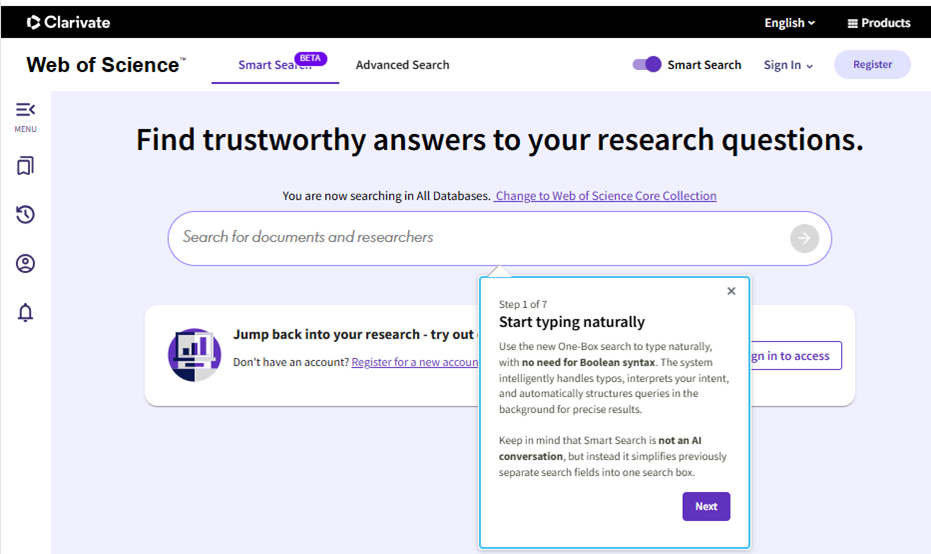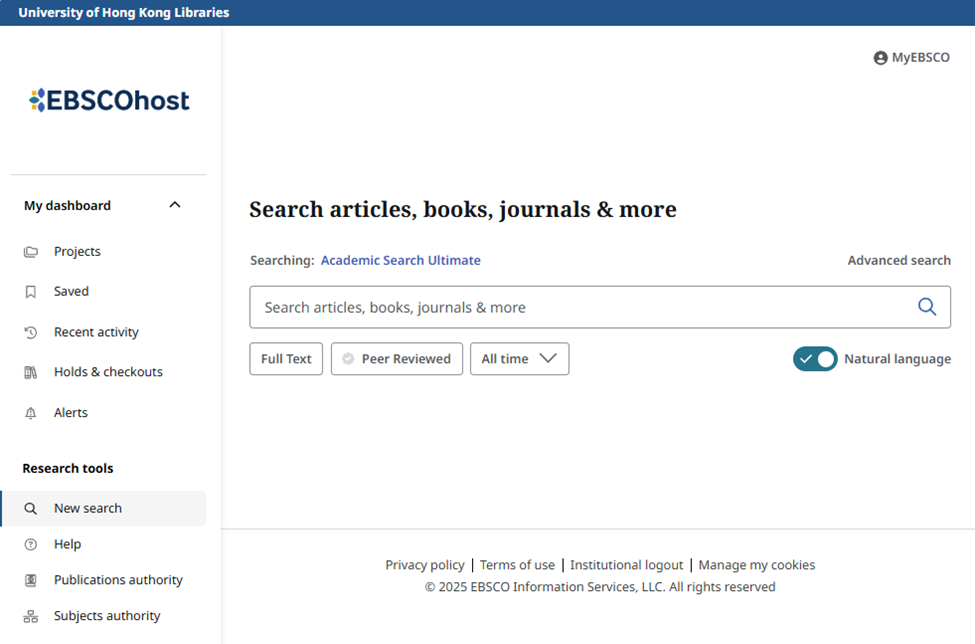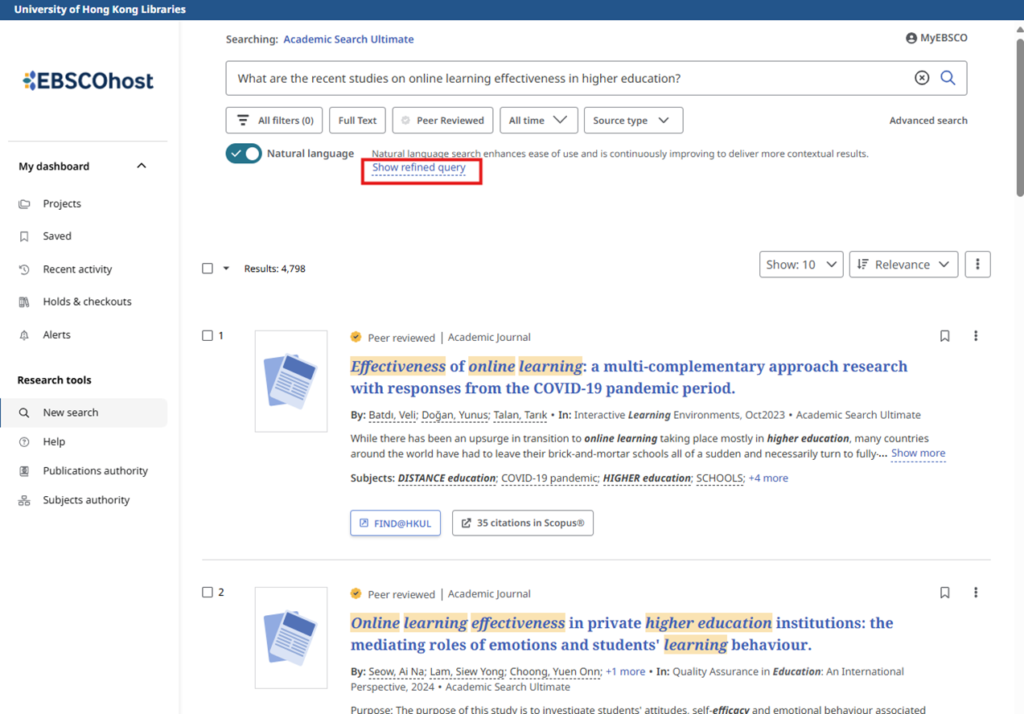
AI Innovations in Academic Search: Comparing Web of Science Smart Search and EBSCOhost Natural Language Search
— by Kanako Hayashi
Academic databases have entered a transformative era with the integration of artificial intelligence (AI). Research found that AI can help researchers, especially those who may not have access to a librarian, to formulate and refine Boolean queries (Qureshi et al., 2023; Reed & Barnett, 2025; Wang et al., 2023). This post compares two AI-enhanced tools — Web of Science (WoS) Smart Search and EBSCOhost Natural Language Search (NLS) — examining their approaches to improving research discovery.
Core Design Philosophies
Web of Science Smart Search
It prioritizes discovery by replacing complex Boolean syntax with intuitive natural language queries. Users can enter queries as they would describe them. Smart Search is launched with support for Simplified Chinese, with plans to add more languages over time.

EBSCOhost Natural Language Search
EBSCOhost NLS focuses on transparency in search logic. It turns a question into a Boolean search query. The “Show refined query” option reveals the generated syntax, allowing users to validate the AI’s interpretation and refine their approach.


AI Implementation
Web of Science Smart Search
When a user enters a query, the proprietary Natural Language Processing (NLP) parser analyzes its structure and context, identifying key elements. Then WoS query is generated and sent to the search engine. There are two types of searches performed at once:
- Boolean search for precision (AND/OR/NOT operators)
- Sematic search using AI-driven technology automatically finding semantically similar terms and incorporates them into the query to retrieve documents beyond exact keyword matches.
Results are ranked using a proprietary algorithm, and users can toggle the result individually on the search results page.
EBSCOhost Natural Language Search
NLS employs large language models (LLMs) to transform natural language queries into Boolean syntax. While it similarly accepts conversational queries (e.g., “What are the recent studies on online learning effectiveness in higher education?”), it leverages large language models (LLMs) to convert it into Boolean expressions (e.g., ((online learning OR distance education) AND (effectiveness OR efficacy) AND (higher education OR university OR college))). While the AI deeply contextualizes search intent, results may vary over time due to model updates.
Transparency
Web of Science Smart Search
Smart Search prioritizes simplicity, keeping AI operations “under the hood” to minimize cognitive load.
EBSCOhost Natural Language Search
By showing transformed Boolean queries, NLS clarifies its search logic and acts as an educational tool for novice researchers.
Use Case Scenarios
Web of Science Smart Search
Smart Search may be useful in the following situations.
- Exploring emerging fields: Quickly identify foundational and influential papers in domains based on citations.
- Conducting multilingual research: Search with Simplified Chinese queries, having bilingual title displays and on-demand abstract translations.
EBSCOhost Natural Language Search
Users can consider using NLS in the following scenarios.
- Learning search strategies: Examine AI-generated Boolean queries to master database syntax.
- Tackling interdisciplinary topics: Search across the multidisciplinary research databases, which effectively bridges domains like “AI regulation in biomedicine”.
Limitations to Consider
Web of Science Smart Search
Smart Search prioritizes citation counts, which may lead to overlooking newer studies or research from non-English speaking regions.
EBSCOhost Natural Language Search
NLS sometimes excessively expands search queries, resulting in the inclusion of irrelevant results.
Common Limitations
Both face common challenges in natural language processing, where they may struggle to accurately understand user intent from expressions, leading to the inclusion of less relevant results in the following situations:
- When the same word has different meanings or its meaning depends on the context.
- When search terms are short, they lack sufficient contextual information to accurately grasp the intent.
In research which requires transparent and consistent search strategies such as systematic reviews, AI-generated search strategy need to be scrutinized, because AI may fabricate controlled vocabulary (MeSH, Medical Subject Headings), and this may not be noticed by whom without expertise in building search queries (Qureshi et al., 2023).
Conclusion
AI technologies are more and more widely adopted in academic databases. For example, Smart Search improves knowledge discovery through citation intelligence, while NLS enhances precision via transparent query mechanics. As these tools evolve, researchers gain the power to focus less on searching and more on insight generation.
References
Clarivate. (2025). Reimagining the Web of Science Search Experience.
https://clarivate.com/academia-government/blog/reimagining-the-web-of-science-search-experience/
Clarivate. (n.d.). Smart Search – Web of Science.
https://webofscience.zendesk.com/hc/en-us/articles/32587676013713-Smart-Search
EBSCO. (2024). Natural Language Understanding in Library Research Platforms – Findings from EBSCO’s Natural Language Search Beta.
https://www.ebsco.com/blogs/ebscopost/natural-language-understanding-library-research-platforms-findings-ebscos-natural
EBSCO. (2025). Natural Language Search: Technical Overview.
https://www.ebsco.com/artificial-intelligence/products/natural-language-search
EBSCO. (2025). EBSCO’s AI Natural Language Search Mode.
https://connect.ebsco.com/s/article/Coming-soon-Introducing-EBSCOs-AI-Natural-Language-Search-Mode?language=en_US
EdUHK Library. (2025). EBSCO’s Natural Language Search mode: No More Keywords to Discover Research.
https://libguides.eduhk.hk/blogs/ai-discovery-zone-eduhk-librarys-research-support/new-feature-from-ebsco-natural-language-sear
IMPERIAL Library Services. (n.d.) Web of Science.
https://library-guides.imperial.ac.uk/web-of-science/SmartSearch
Liu, Y. et al. (2023). Semantic Search in Academic Databases: A BERT-Based Approach. Journal of Information Science, 49(2), 210-225.
https://jisem-journal.com/index.php/journal/article/download/7884/3594/13141
Qureshi, R., Shaughnessy, D., Gill, K. A. R., Robinson, K. A., Li, T., & Agai, E. (2023). Are ChatGPT and large language models “the answer” to bringing us closer to systematic review automation? Systematic Reviews, 12(1), 72. https://doi.org/10.1186/s13643-023-02243-z
Reed, R. B., & Barnett, D. J. (2025). Assessing the Quality of Biomedical Boolean Search Strings Generated by Prompted and Unprompted Models Using ChatGPT: A Pilot Study. Medical Reference Services Quarterly, 44(1), 31-40. https://doi.org/10.1080/02763869.2024.2440848
Wang, S., Scells, H., Koopman, B., & Zuccon, G. (2023). Can ChatGPT write a good boolean query for systematic review literature search? In Proceedings of the 46th international ACM SIGIR conference on research and development in information retrieval (pp. 1426-1436) https://doi.org/10.1145/3539618.3591703


